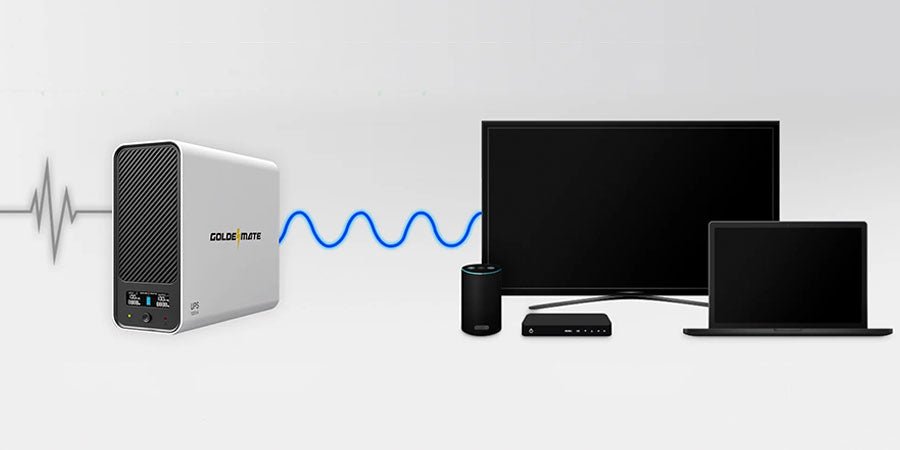Uninterruptible Power Supply (UPS)
Guide to choosing the right UPS Size to run Your Appliances in Kenya
Guide to choosing the right UPS Size to run Your Appliances in Kenya
Selecting the right Power backup UPS (Uninterruptible Power Supply) capacity is one of the most important decisions you can make when protecting your home or business equipment in Kenya. Your UPS must be powerful enough to keep your devices running safely during a blackout — but not so large that you waste money or energy on excess capacity.
Many Kenyan buyers struggle to balance cost, power requirements, and runtime. This guide will help you understand how to calculate the right UPS VA size step-by-step, using real-world examples for homes, offices, and small businesses. Whether you’re backing up a Wi-Fi router, desktop PC, or small server, these calculations ensure you get the perfect UPS size for your load and budget.
For a full overview of UPS types, capacities, and maintenance best practices, Read Our Complete Guide to Buying the Right Power Backup UPS in Kenya
Understanding UPS VA Rating
VA (Volt-Amps) rating measures how much apparent power a UPS can deliver to your connected devices.
To determine what size UPS you need, you must first calculate your total load in watts (W), convert it to VA, and then add a 20–30% safety buffer to account for startup surges and future expansion.
Quick Tip: For most electronics in Kenya, the power factor (PF) ranges from 0.8 to 0.9. This means that:
VA = Watts ÷ 0.8 (or 0.9)
Step-by-Step: How to Calculate Your UPS Size
Step 1: List Your Appliances
Write down every device you plan to connect to the UPS. Common examples include:
- Desktop computer or laptop
- Monitor
- Router / Wi-Fi
- CCTV DVR and cameras
- Printer, POS, or external hard drives
Step 2: Check the Wattage of Each Device
Look at the power rating label on your equipment or check the manufacturer’s documentation. Each device lists power consumption in Watts (W).
Step 3: Add Up the Total Wattage
Simply sum the wattage of all connected devices.
Example:
- Computer: 100W
- Monitor: 30W
✅ Total = 130W
Step 4: Convert Watts to VA
Use the formula below to find the total VA your UPS needs to handle:
VA = Watts ÷ Power Factor
For most office or home electronics, assume Power Factor = 0.8.
Example:
130W ÷ 0.8 = 162.5VA
Step 5: Add a 20–30% Safety Buffer
Never run a UPS at full capacity. Adding a buffer protects the system, extends battery life, and allows for extra devices in the future.
Example:
162.5 VA + 25% buffer = ≈200–250VA UPS
Recommended UPS Capacities in Kenya
| Application | Recommended UPS Capacity (VA) | Typical Usage |
| Home Wi-Fi router & CCTV DVR | 600VA | 1–2 hours runtime |
| Desktop PC + Monitor | 650–850VA | 15–30 minutes |
| Gaming PC or Console | 1000–1500VA | 20–45 minutes |
| Small Office (multiple PCs) | 2KVA | 30–60 minutes |
| Server Room / Data Center | 3KVA+ | Continuous or modular setups |
➡️ Shop UPS systems by size in Kenya and find the right model for your setup.
Why You Should Always Add a Buffer
Adding a 20–30% buffer when sizing your UPS offers three key advantages:
- Prevents overloads and premature shutdowns.
- Improves battery performance by reducing strain during peak loads.
- Allows future expansion if you add more equipment later.
Common UPS Sizing FAQS
What happens if I buy a UPS that’s too small?
It will overload immediately and shut down, leaving your devices unprotected.
Is VA the same as Watts?
Not exactly. Watts measure real power, while VA measures apparent power. You must divide total watts by your power factor (usually 0.8) to get the right VA.
How can I calculate UPS runtime?
Use our UPS runtime calculator for Kenya — it estimates backup time based on your load and UPS battery size.
Can a 650VA UPS run my fridge or microwave?
No. High-consumption appliances require an inverter or industrial-grade Online UPS (3KVA and above).
To calculate how much UPS VA you need in Kenya:
- Add up the total wattage of your connected devices.
- Divide the total by 0.8 to get the VA.
- Add a 20–30% buffer for safety and expansion.
For home and small office setups, a 600VA–1000VA UPS is usually enough.
For servers, data centers, and mission-critical systems, invest in a 3KVA+ Online UPS for continuous, clean power.
➡️ Calculate your UPS size now and shop UPS systems in Kenya from trusted brands like APC, Mecer, Mercury, and Secureye at Tronik Kenya.


